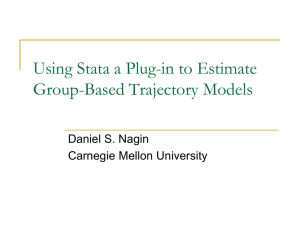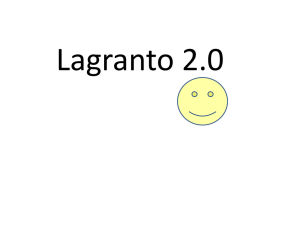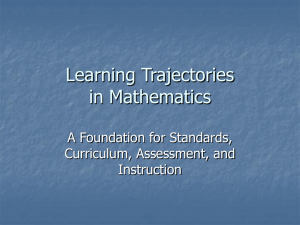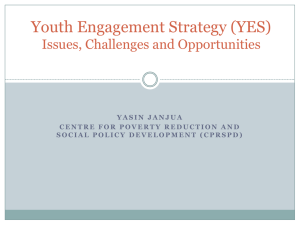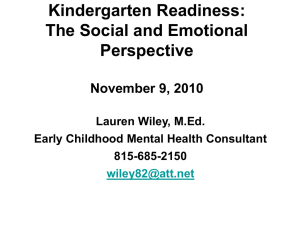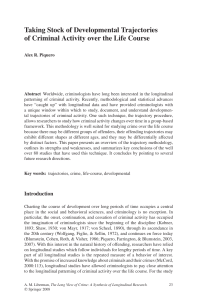Group-based trajectory modeling: An overview
advertisement
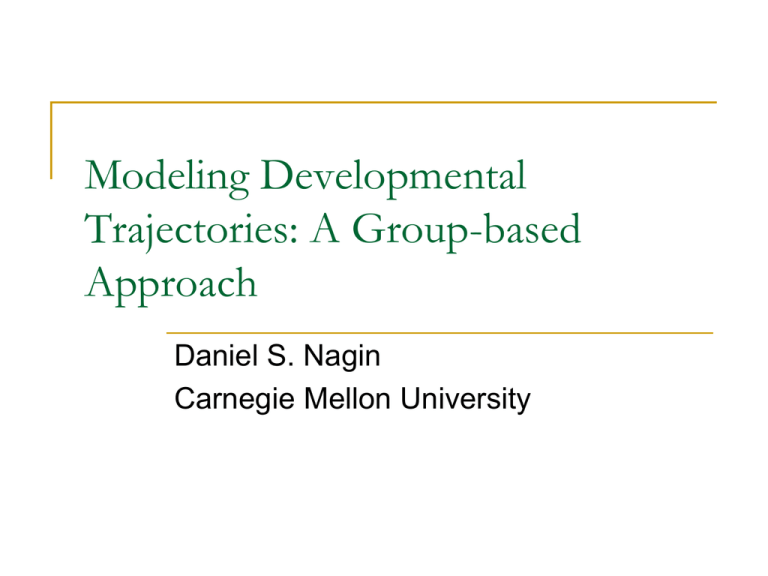
Modeling Developmental Trajectories: A Group-based Approach Daniel S. Nagin Carnegie Mellon University What is a trajectory? A trajectory is “the evolution of an outcome over age or time.” (p.1) Nagin. 2005. Group-Based Modeling of Development, Harvard University Press Types of Trajectory Modeling Grow Curve Modeling Grow Mixture Modeling (GMM)-Muthén and colleagues Group-Based Trajectory Modeling (GBTM)Nagin and colleagues For a recent discussion of differences see Nagin and Odgers (2010) Trajectory Estimation Software Proc Traj Mplus Specialized SAS based STATA version in Beta Testing General Purpose Its “own platform” Latent Gold (?) R-based packages Physical Aggression Trajectories of Physical Aggression (Child Development, 1999) 4.5 4 3.5 3 2.5 2 1.5 1 0.5 0 4% 28% 52% 16% 6 Low-actual Low-pred. 10 11 12 13 14 Mod. desister-actual Age High desister-actual Mod. desister-pred. High desister-pred. 15 Chronic-actual Chronic-pred Antisocial Behavior Trajectories (N=526 Conduct Problems Scale males) 7 9 11 13 15 18 21 26 Age Odgers, Caspi et al., Arch Gen Psychiatry, 2007 Motivation for Group-based Trajectory Modeling Testing Taxonomic Theories Identifying Distinctive Developmental Paths in Complex Longitudinal Datasets Capturing the Connectedness of Behavior over Time Transparency in Efficient Data Summary Responsive to Calls for “Person-based Methods of Analysis The Likelihood Function P (Y i ) j ( x i ) P (Y i ) j j J P (Y i) = p ro b ab ility o f Y i given m em b ersh ip in grou p j j= p ro b ab ility o f m em b ersh ip in grou p j j ( xi ) e x i j N L P (Y i ). e x i j Using Groups to Approximate an Unknown Distribution Panel A f(z) 0.10 0.05 0.00 0 10 20 z z Panel B f(z) 0.10 0.05 0.00 0 z1 10 z2 z3 z 20 z4 z5 Implications of Using Groups to Approximate a More Complex Underlying Reality Trajectory Groups are latent strata—individuals following approximately the same developmental course of the outcome variable Groups membership is a convenient statistical fiction, not a state of being Individuals do not actually belong to trajectory groups Trajectory group “members” do not follow the group-level trajectory in lock-step Groups are not immutable # of groups will depend upon sample size and particularly length of follow-up period Search for the True Number of Groups is a Quixotic exercise Calculation & Use of Posterior Probabilities of Group Membership pˆ ( group j | data i ) pˆ ( data i | group j )ˆ j pˆ ( data i | group j )ˆ j j Maximum Probability Group Assignment Rule Group Profiles V ariable G ro up N ever Low D esister H igh D esister Y ears o f S cho o l - M o ther 11.1 10.8 9.8 8.4 Y ears o f S cho o l - Father 11.5 10.7 9.8 9.1 26.8 44.5 46.4 L o w IQ (% ) 21.6 th C hro nic C o m pleted 8 G rade o n T im e (% ) 80.3 64.6 31.8 6.5 Juvenile R eco rd (% ) 0.0 2.0 6.0 13.3 1.7 2.2 3.5 # o f S exual P artners at A ge 17 (P ast Y ear) 1.2 Other Uses of Posterior Probabilities Computing Weighted Averages That Account for Group Membership Uncertainty (Nagin (2005; Section 5.6) Diagnostics for Model Fit (Section 5.5) Matching People with Comparable Developmental Histories (Haviland, Nagin, and Rosenbaum, 2007) Statistically Linking Group Membership to Individual Characteristics (Chapter 6) Moving Beyond Univariate Contrasts Group Identification is Probabilistic not Certain Use of Multinomial Logit Model to Create a Multivariate Probabilistic Linkage j ( xi ) e x i j e x i j Risk Factors for Physical Aggression Trajectory Group Membership Broken Home at Age 5 Low IQ Low Maternal Education Mother Began Childbearing as a Teenager 0.7 0.6 0.5 0.4 0.3 0.2 0.1 0 Low Moderate Declining High Declining Ho me Lo w Ed M om Te en M om Al lR is k s IQ Br ok en Lo w sk Chronic Ri No probability Impact of Risk Factors on Group Membership Probabilities Does School Grade Retention and Family Break-up Alter Trajectories of Violent Delinquency Themselves? (Nagin, 2005; Development and Psychopathology 2003) Trajectories of Violent Delinquency 10 9 8 7 Rate 6 5 4 3 2 1 0 11 12 Low 1 (34.8$) Declining (16.7%) 13 14 Age Low 2(30.6%) Chronic (4.5%) 15 16 Rising (13.4%) 17 The Overall Model Z1 Z2 Z3 Z4 Z5 ………. …. Zm Probability of Trajectory Group Membership Trajectory 1 Trajectory 2 X1t X2t Trajectory 3 Trajectory 4 X3t……………Xlt Model of Impact of Grade Retention and Parental Separation on Trajectory Group j Model without retention or separation impact: ln( ) j t j 0 1 Age t Age j j 2 2 t Trajectory with retention and separation impacts: ~ ~ ~ ln( ) 0 1 Age t 2 Age t 1 Fail j t j j j 2 j 2 Separation j t t Dual Trajectory Analysis: Trajectory of Modeling of Comorbidity and Heterotypic Continuity (Nagin and Tremblay, 2001; Nagin (2005) Panel A-Conventional Approach Behavior X: X1 X 2 X3 ……………… XT Comorbidity Behavior Z: Behavior X: Z1 X1 Z2 X 2 Z3 X3 ……………… ……………… ZT XT Heterotypic Continuity Behavior Z: ZT ZT+1 Zt+3 ……………… ZT+K Panel B-Dual Trajectory Approach Behavior X: X1 X Behavior Z: Z1 Z2 Z3 X X3 2 X3 ……………… XT Comorbidity Behavior X: X1 2 ……………… ……………… ZT XT Heterotypic Continuity Behavior Z: ZT ZT+1 Zt+3 ……………… ZT+K Modeling the Linkage Between Trajectories of Physical Aggression in Childhood and Trajectories of Violent Delinquency in Adolescence Trajectories of Adolescent Violent Delinqunecy from Age 13 to 17 4 3 Low 2 Desisting 1 High 0 6 8 10 Age 12 Rate Physical Aggression Trajectories of Childhood Physical Aggression from Age 6 to 13 9 8 7 6 5 4 3 2 1 0 Low 1 Low 2 Declining Rising Chronic 13 14 15 Age 16 17 Transition Probabilities Linking Trajectories in Adolescent to Childhood Trajectories Trajectory in Adolescence Trajectory in Childhood Low 1&2 Rising Declining Chronic .889 .092 .019 .000 Declining .707 .136 .128 .029 High .215 .206 .158 Low .422 The Dual-Trajectory Model Generalized to Include Predictors of Conditional Probabilities Are drug use and family break-up at age 12 predict the conditional probabilities linking childhood physical aggression trajectories with adolescent violent delinquency trajectories? Answer: yes for drug use but no family break-up Conditional probabilities specified to follow a “constrained” multinomial logit function (see section 8.7 of Nagin) Probability of Transition to Chronic Trajectory Depending on Drug Use at Age 12 and Childhood Physical Aggression Trajectory Drug Use at age 12 None 75th Percentile Low Moderate High Physical Physical Physical Aggression Aggression Aggression .00 .02 .12 .00 .18 .46 Multi-Trajectory Modeling Linking Trajectories to Later Out Comes— Trajectories of Physical Aggression from 6 to 15 and Sexual Partners at 16 Accounting for Non-random Subject Attrition 30 Accounting for Non-random Subject Attrition (cont.) 31 Recommended Readings Nagin, D.S. and C.L. Odgers. 2010. “Group-based trajectory modeling in clinical research.” In S. Nolen-Hoekland, T. Cannon, and T. Widger (eds.), Annual Review of Clinical Psychology. Palo Alto, CA: Annual Reviews. Nagin, D. S. 2005. Group-based Modeling of Development. Cambridge, MA.: Harvard University Press. Nagin, D.S. and R. E. Tremblay. 2005. “Developmental Trajectory Groups: Fact or a Useful Statistical Fiction?.” Criminology, 43:873904. Nagin, D. S., and R. E. Tremblay. 2001. “Analyzing Developmental Trajectories of Distinct but Related Behaviors: A Group-based Method.” Psychological Methods, 6(1): 18-34. Nagin, D. S. 1999. “Analyzing Developmental Trajectories: A Semiparametric, Group-based Approach.” Psychological Methods, 4: 139-177. Nagin, D.S., Pagani, L.S., Tremblay, R.E., and Vitaro, F. 2003. “Life Course Turning Points: The Effect of Grade Retention on Physical Aggression.” Development and Psychopathology, 15: 343-361. Suggested Readings Continued Jones, B., D.S. Nagin. And K. Roeder. 2001. “A SAS Procedure Based on Mixture Models for Estimating Developmental Trajectories.” Sociological Research and Methods, 29: 374-393. Jones, B. and D.S. Nagin. 2007. “Advances in Group-based Trajectory Modeling and a SAS Procedure for Estimating Them,” Sociological Research and Methods, 35: 542-571. Haviland, A., Nagin D.S., and Rosenbaum, P.R. 2007. “Combining Propensity Score Matching and Group-Based Trajectory Modeling in an Observational Study” Psychological Methods, 12: 247-267.
